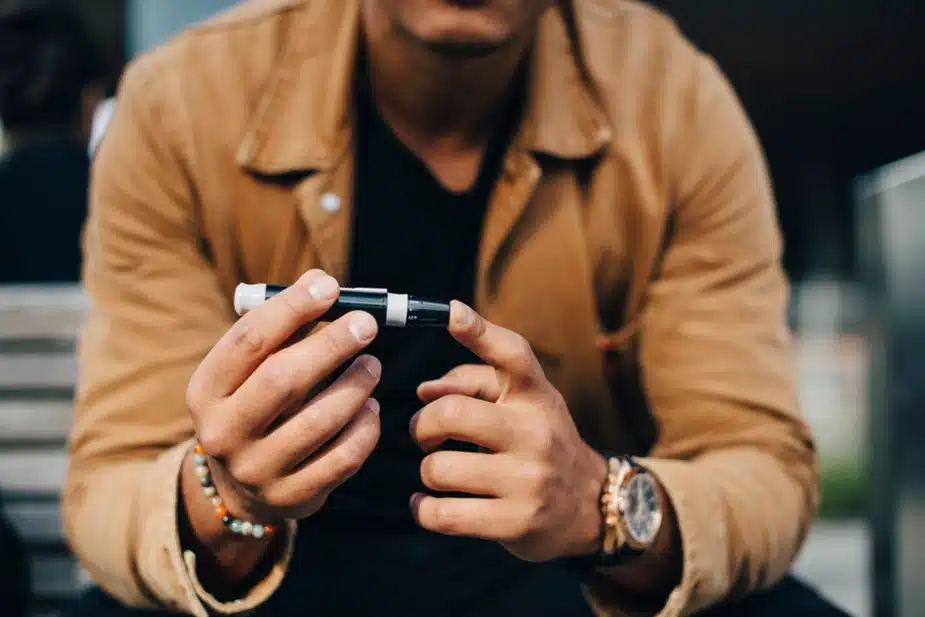Can glucose cause you pain? Is pain a consequence of diabetes! – Have you ever wondered why? Get to know why people with diabetes experience signs and symptoms of pain. What is diabetic foot pain? What does diabetic foot pain feel like? Can diabetic neuropathy be reversed? What are the best vitamins for diabetics?
Diabetes
According to World Health Organization (WHO), diabetes is a chronic, metabolic disease characterized by increased blood glucose levels (or blood sugar), which leads over time to serious damage to the heart (cardiomyopathy), blood vessels, eyes (retinopathy), kidneys (nephropathy) and nerves (neuropathy) [1]. The prominent physical form of diabetes that decreases productivity of life is pain caused by diabetic neuropathy – damage to nerves due to high glucose.
Diabetic Neuropathy
Diabetic neuropathy affects about 40.3% of diabetic patients, especially with type-2 diabetes mellitus (T2DM) with 42.2% prevalence and 29.1% prevalence in type-1 diabetes mellitus (T1DM) [2]. Diabetic neuropathy mostly affects the peripheral nerves, especially sensory nerve fibers; hence it’s referred to as diabetic peripheral neuropathy. The increased glucose levels in the blood of diabetic patients cause pain by affecting the nerves and increasing the sensitization of the nerves to normal stimuli. The normal stimulus of touch, pressure, heat, cold, prick, pinch, etc., may be painful in diabetic patients because of the nerve damage termed as allodynia [3]. This kind of pain is experienced mostly in either foot of diabetic people – also known as diabetic foot pain.
Effect of glucose on nerves and pain
Glucose/sugar from the diet has to be taken up by cells for storage and energy production, but when it’s not taken up; it leads to hyperglycemia (increased glucose levels in the blood). The free glucose then acts on other cell surface proteins leading to increased distortions inside the neuronal cells increasing the oxidant stress. This oxidant stress by reactive oxygen species (ROS) is free radicals that damage the neuronal cell membrane, cellular proteins, and other bio-organic molecules within the cell. The neuronal cell function is interrupted and increases impulse/signal. This impulse/signal causes hypersensitization of nerves to normal and painful stimuli [4]. As glucose causes pain, the diabetic foot pain can be reversed to some extent by controlling the blood glucose.
Pain transmission
Pain as defined by the International Association for the Study of Pain (IASP) is “An unpleasant sensory and emotional experience associated with, or resembling that associated with, actual or potential tissue damage” [5]. Pain that we normally experience may be beneficial in case of fire(heat), sharp objects, cold, etc., that alerts us from preventing more damage to the body. But the pain caused in diabetic patients is not defensive, but rather offensive. The nerve fibers that are involved in pain, sense it from peripheral nerves predominantly in the palm, feet, legs, hands, etc.; transmit it to the spinal cord and brain to recognize, that the stimulus is pain. The reflex action of the nerves from the brain to the hands and legs makes you withdraw, from that contact causing pain [6].
In the case of diabetic neuropathic pain or most commonly diabetic foot pain, the pain originates in the nerve itself and is transmitted leading to no physical withdrawal of objects to reduce pain.
What does diabetic foot pain feel like?
The patients experience continuous pain sensation types like:
1. Stabbing sensation
2. Throbbing sensation
3. Electric shock-like sensation
4. Numb sensation
5. Shooting sensation
6. Burning sensation
7. Pins and needles sensation

Early diagnosis and consultation
Early diagnosis and prevention include strict control of blood glucose at early stages. There is evidence that obesity and hypertriglyceridemia can have the risk of diabetic peripheral neuropathy in patients with type-2 diabetes mellitus. Diagnosis or detection is done based on a grading system using questionnaires/scales. This grading system based on relevant history, pain distribution, sensory signs, and a diagnostic test confirming a lesion or disease of the nervous system, makes it possible to classify the pain [7].
ICD 10 code for diabetic neuropathy is used to find the occurrence, prevalence, and diagnosis, in which chapter G & E diagnosis codes can detect type 2 diabetes patients with hospital-diagnosed diabetic neuropathy which are also used in an epidemiological survey. Consult a diabetologist and neurologist to control the incidence of pain, before it worsens.
Effect of OTC pain medicines on diabetic neuropathic pain
OTC (over-the-counter) pain medicines under the class termed NSAIDs (non-steroidal anti-inflammatory drugs) provide relief only to mild to moderate pain and do not interfere with the exact cause of pain by diabetes. Diabetic foot pain is a chronic condition and appropriate medications should be taken to relieve pain [8]. Consult your pharmacist, nurse, physician, clinician, or other healthcare personnel about the safe use of medicines.
Can diabetic neuropathy be reversed?
Well, diabetic neuropathy or diabetic foot pain cannot be cured completely, but the pain symptoms can be controlled with a few supplements or vitamins and a better lifestyle is possible by following the suggestions below.
Supplements/ Vitamins for Diabetics
Few supplements or vitamins for diabetics that may energize your nerves to heal quicker are
1. Vitamin B1, B6, B12
2. α-lipoic acid
3. Acetyl L-carnitine
4. N-acetyl cysteine
5. Curcumin
6. Omega-3 fatty acids
Use the supplements or vitamins for diabetics only after consultation with healthcare professionals

Suggestions
1. Control your blood sugar/blood glucose for preventing pain
2. Any signs or symptoms – do not neglect
3. Physiotherapy may help
4. Take a hot shower and try keeping your palm, hand, leg, or feet in the warm water bath
5. Do not lift heavy weights
6. Be optimistic and socialize with the outside world or nature to have good mental health.
Take home message
The strict control of blood glucose is necessary, especially in adults over 35 years and the geriatric (old age) population. Controlling glucose is also required for preventing pain.
Good health comes with a good gut, take care of the food you eat.
Consult a physician or pharmacist in case of any symptoms you experience being a diabetic patient since diabetes has a series of complications that can be prevented if detected early.
Supplements or other nutraceuticals or vitamins for diabetics should be consumed only after confirmation with healthcare personnel, to check for drug interactions.
References
1. https://www.who.int/health-topics/diabetes#tab=tab_1
2. Pfannkuche, A., Alhajjar, A., Ming, A., Walter, I., Piehler, C., & Mertens, P. (2020). Prevalence and risk factors of diabetic peripheral neuropathy in a diabetics cohort: Register initiative “diabetes and nerves”. Endocrine And Metabolic Science, 1(1-2), 100053.
3. Veves, A., Backonja, M., & Malik, R. (2008). Painful Diabetic Neuropathy: Epidemiology, Natural History, Early Diagnosis, and Treatment Options. Pain Medicine, 9(6), 660-674.
4. Yagihashi, S., Mizukami, H., & Sugimoto, K. (2011). Mechanism of diabetic neuropathy: Where are we now and where to go?. Journal of diabetes investigation, 2(1), 18–32.
5. https://www.iasp-pain.org/publications/iasp-news/iasp-announces-revised-definition-of-pain/
6. Colloca, L., Ludman, T., Bouhassira, D., Baron, R., Dickenson, A. H., Yarnitsky, D., Freeman, R., Truini, A., Attal, N., Finnerup, N. B., Eccleston, C., Kalso, E., Bennett, D. L., Dworkin, R. H., & Raja, S. N. (2017). Neuropathic pain. Nature reviews. Disease primers, 3, 17002.
7. Burgess, J., Frank, B., Marshall, A., Khalil, R.S., Ponirakis, G., Petropoulos, I.N., Cuthbertson, D.J., Malik, R.A., & Alam, U. (2021). Early Detection of Diabetic Peripheral Neuropathy: A Focus on Small Nerve Fibres. Diagnostics, 11(2), 165.
8. Vo, T., Rice, A., & Dworkin, R. (2009). Non-steroidal anti-inflammatory drugs for neuropathic pain: How do we explain continued widespread use?, Pain, 143(3), 169-171

Prashanth P
Related Posts

Prostadine Reviews: Unlocking the Potential for Prostate Health



Local Delicacies: A Path to Combat the Surge in Non-Communicable Diseases


